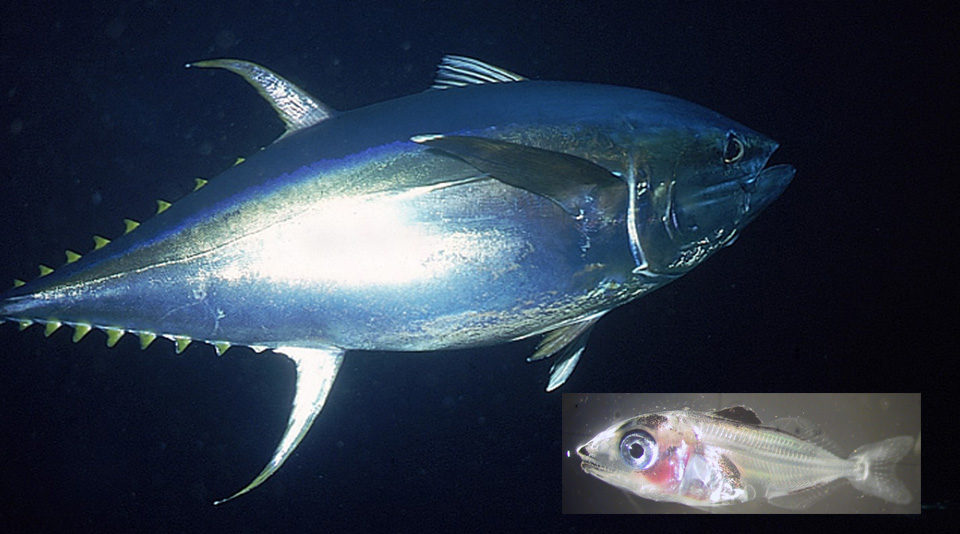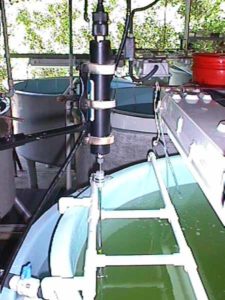Three levels of turbulence were created in experimental tanks

The Inter-American Tropical Tuna Commission (IATTC) operates the Achotines Laboratory on the southern tip of the Azuero Peninsula of Panama. Research at the laboratory centers on tuna biology, but studies of other marine and terrestrial organisms are conducted by visiting scientists.
A captive population of yellowfin tuna (Thunnus albacares) spawns routinely at the Achotines Laboratory. The larvae hatched from eggs spawned by these broodstock are used in experiments to gain a better understanding of the biology of larval, juvenile and adult tuna.
Microturbulence effects

Several recent experiments were conducted to examine the effects of microturbulence on the feeding and survival of yellowfin larvae. During one phase of the experiments, IATTC scientists worked with Drs. Hideaki Nakata of Nagasaki University and Shingo Kimura of the Ocean Research Institute at the University of Tokyo.
To simulate the ocean environment on a laboratory scale, three levels (low, medium, and high) of turbulence were created in experimental tanks. Daily measurements of the turbulent velocities were made in each tank with a micro acoustic Doppler current meter. This instrument measures turbulence velocities in three dimensions simultaneously on a microscale level. The lowest survival of yellowfin larvae occurred at low and high turbulence. Feeding success and survival were markedly greater at medium turbulence levels.
The experimental turbulence data was used to identify an optimal range of turbulence for larval feeding success and survival. For tuna biologists and ecologists, comparing the optimal experimental levels of turbulence with historical data on levels of wind-induced mixing in the tropical eastern Pacific is of primary interest.
If similar levels of wind-induced mixing are identified, they can be compared to yellowfin recruitment levels for the same time periods to identify patterns of association between wind-induced mixing and yellowfin recruitment. For tuna culturists, the turbulence data can provide a reference to set optimal water flow and aeration levels to promote successful feeding in larval-rearing tanks.
Other research
To enable scientists to culture tuna for biological experiments, research will continue at the Achotines Laboratory on broodstock nutrition and resulting egg quality, artificial feeds for larval and juvenile tuna, and enzyme studies of the developing gastrointestinal tracts of tuna larvae and juveniles.
Further studies are examining RNA/DNA ratios to compare growth potential between wild and cultured fish, and the development of vision in tuna. Such basic biological information will also have practical applications for the mariculture of tuna and other pelagic species.
(Editor’s Note: This article was originally published in the February 2004 print edition of the Global Aquaculture Advocate.)
Now that you've finished reading the article ...
… we hope you’ll consider supporting our mission to document the evolution of the global aquaculture industry and share our vast network of contributors’ expansive knowledge every week.
By becoming a Global Seafood Alliance member, you’re ensuring that all of the pre-competitive work we do through member benefits, resources and events can continue. Individual membership costs just $50 a year. GSA individual and corporate members receive complimentary access to a series of GOAL virtual events beginning in April. Join now.
Not a GSA member? Join us.
Authors
-
Vernon Scholey, M.S.
Inter-American Tropical Tuna Commission
Achotines Laboratory
Las Tablas, Los Santos Province
Panama -
Daniel Margulies, Ph.D.
Inter-American Tropical Tuna Commission
La Jolla, California, USA -
Jeanne Wexler
Inter-American Tropical Tuna Commission
La Jolla, California, USA -
Sharon Hunt, M.S.
Inter-American Tropical Tuna Commission
La Jolla, California, USA
Tagged With
Related Posts

Health & Welfare
Achotines laboratory home to continuing studies of tuna early life history
The Inter-American Tropical Tuna Commission Achotines Laboratory in southern Panama is the world’s only facility with nearly year-round availability of tuna eggs and larvae. A study is comparing the reproductive biology, genetics and early life history of yellowfin and Pacific bluefin tuna.

Health & Welfare
Marine fish culture in Mexico
Mexico has a wide diversity of areas and water temperatures that are suitable for a variety of aquaculture species.

Responsibility
Tuna aquaculture faces challenges in continued growth
One of the chief limitations for the tuna aquaculture industry is its primary dependence on diminishing wild fish to stock marine cages.

Intelligence
Byproduct utilization for increased profitability, part 1
Protease enzymes are important industrial enzymes that have diverse applications in food, leather, silk and the agrichemical and pharmaceutical industries. Fish are considered one of the richest sources of proteolytic enzymes.


